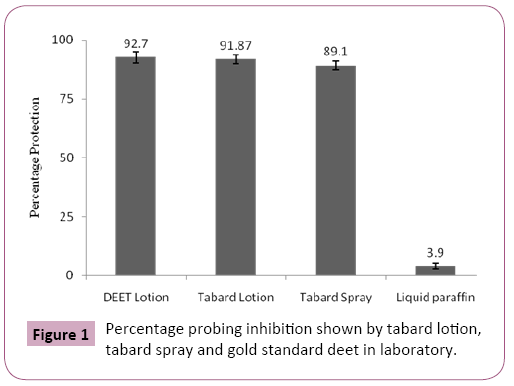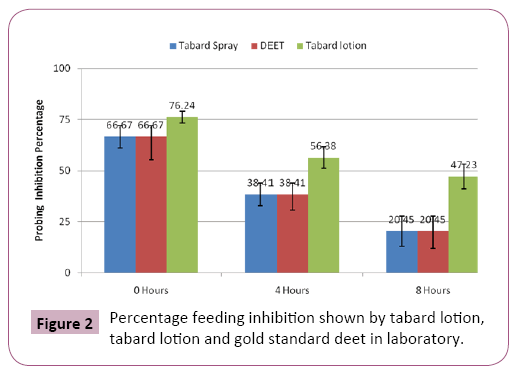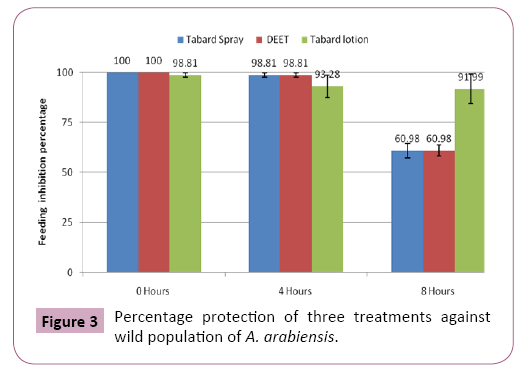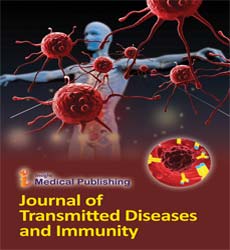ISSN : 2573-0320
Journal of Transmitted Diseases and Immunity
Bio-efficacy of Tabard Spray and Tabard Lotion against Malaria Vectors in Laboratory and in the Field Conditions
Temba V1, Lyaruu LJ1, Mahande AM2 and Kweka EJ1,3*
1Division of Livestock and Human Diseases Vector Control, Tropical Pesticides Research Institute, Arusha, Tanzania
2Mabogini Field Station, Tropical Pesticides Research Institute, Moshi, Tanzania
3Department of Medical Parasitology and Entomology, Catholic University of Health and Allied Sciences, Mwanza, Tanzania
- *Corresponding Author:
- Kweka EJ
Division of Livestock and Human Diseases Vector Control
Tropical Pesticides Research Institute
PO Box 3024 Arusha, Tanzania
Tel: +255 754 368748
E-mail: kwekae@tpri.or.tz
Received Date: September 01, 2017; Accepted Date: October 09, 2017; Published Date: October 20, 2017
Citation: Temba V, Lyaruu LJ, Mahande AM, Kweka EJ (2017) Bio-efficacy of Tabard Spray and Tabard Lotion against Malaria Vectors in Laboratory and in the Field Conditions. J Transm Dis Immun Vol.1 No.2:16
Abstract
Personal protection tools are of paramount importance for the control of residual malaria transmission in both urban and rural settings. The current study evaluated the repellant efficacy of Tabard lotion and Tabard spray against a standard DEET (N, N-diethyl-3-methylbenzamide). Bioassays were conducted to evaluate the efficacy of Tabard lotion, Tabard spray and DEET against Anopheles gambiae s.s. in the laboratory and in field situations. Field evaluations were carried out from 1800 h to 0300 h. Protection efficiency of above 90% was achieved for Tabard (both spray and lotion) and DEET while the feeding inhibition was not found to be statistically different, but decreased for both after 8 hours of application from 100% to 60.98% in spray and 98.81% to 91.99% in lotion. Probing inhibition of the two repellants decreased with time. No any adverse side effect was reported from the field and laboratory participants who applied the evaluated products in their skin. The findings of this study have proved to be protective for 8 from anopheles mosquitoes bites.
Keywords
Anopheles gambiae s.l.; Tabard lotion; DEET; Tabard spray; Vectors
Introduction
Reduction of Human vector contact is of most important in reducing malaria transmission. In recent past, WHO report have indicated that malaria death and morbidity related cases have been reduced significantly globally [1]. The major tools for malaria vector control which have lead to the observed decline of malaria related death cases and morbidity are IRS and LLIN coverage programmes [1]. Due to this achievement, malaria transmission has decreased tremendously to residual malaria transmission [2-4]. More efficient tools such as personal protection tools are needed to add value on the achieved efforts. Since its inception in market as a repellent, DEET has performed well with a protection of up to 8 hours since topically applied [5-10]. Having more brands of repellents in market gives user opportunity to avoid those with allergic reactions with.
Protection from arthropod bit is best achieved by avoiding infested habitants, wearing protective clothing and using Insect repellants [5,6]. In many ways direct application of repellent on skin might increase protection against biting Insects. Given that, a single infectious bite can result into disease transmission its very useful to know which repellant product can be relied on to provide prolonged prevention from vector bites. The best known chemical insect repellent is N, N-diethyl-m-toluamide, now called N, N-diethyl-3-methylbenzamide (DEET) [5,6,10].
This trial evaluated Tabard lotion and Tabard spray with DEET (15%) as active ingredient compared to gold standard DEET lotion (20%) in laboratory and field situation against Anopheles gambiae s.l.
Methods
Tabard lotion (TL) and Tabard sprays (TS) are mosquito repellents, with 15% N-N Diethyl Benzamide, these products were evaluated for their efficacy against anthropophillic mosquitoes. DEET (97% N-N methyl toluamide), was tested alongside TS and TL as a gold standard for comparison purposes. The study was carried out from November, 2016 to January, 2017 in the laboratories while field trials were conducted at Lower Moshi irrigates rice fields, 10 km South of Moshi town.
In laboratory screening
The tests were conducted at Tropical Pesticide Research institute (TPRI) located at Ngaramtoni-Arusha, Tanzania in a laboratory maintained at 27 ± 2°C and 78-80% relative humidity. Laboratory reared 3-5 day old female unfed mosquitoes were used for bioassays. Testing was done in the laboratory maintained at standard temperature and humidity against laboratory strains of Anopheles gambiae s.s. in cage bioassays using authors as human volunteers (Eliningaya Kweka, Violet Temba and Lucile Lyaruu). The following repellant were tested: TL and TS contained 15% N-N Diethyl benzamide. The repellant was applied on an approximate 98 cm² area of one of the fore arm of the volunteers while wearing gloves to cover the fore arm.
Evaluation of probing inhibition for A. gambiae using TS, TL and DEET lotion was carried out in two cages each containing a total of 50 unfed females of A. gambiae s.s.. The mosquitoes were introduced in cages with 30 x 30 x 30 cm dimension. The arm of a person treated with TL or TS was introduced in the cages and the number of mosquitoes landing on arms were countered on evaluated repellants while using DEET (lotion or spray) as positive control. Each experiment had three replicates and repeated 3 times.
At the same time, evaluation of feeding inhibition for A. gambiae was carried out using TS, TL and DEET (lotion and spray). Two cages each containing a total of 50 unfed females were exposed for 30 minutes on arms treated with liquid paraffin (negative control), arm treated with TL or TS containing DEET 15% and with DEET (lotion and spray) containing DEET 20%. The proportions of fed mosquitoes were recorded for each category of treatment. Also experiment had three replicates and repeated 3 times.
Field trials
In the field six teams each with two individuals of 18 years and above were selected for conducting of human landing catches for the trials. Six sites were selected and each team applied TL, TS, DEET and control group applied liquid paraffin. Each group applied at 17:30hrs and sampling started at 1800hrs to 0300hrs. The design was 4 by 4 Latin square experiments. Mosquitoes collected hourly were preserved in the cups and transported to laboratory for identification.
Probing inhibition was calculated using the formula for probing inhibition percentage
=(CP–TP/ Cp+TP) x 100%.
From the equation, Cp is the number of mosquitoes probed in control arm, Tp is the number of mosquitoes probed in treatment arm.
After calculating the probing inhibition percentages, they were compared by paired samples t-test between evaluated product TL, TS and DEET. The same was done for feeding inhibition using WHO guideline for testing repellents [11].
The field data were analyzed with General linear model univariate analysis with mosquitoes as independent variable, treatment fixed factor and days as random factor.
Results
In the laboratory comparison of probing percentage inhibition between Tabard lotion, Tabard spray and DEET lotion was found that, probing inhibition percentage for TL, TS and DEET lotion had no statistical difference on 0 hour (P=0.216), after 4 hours (P=0116) and after 8 hours (P=0.122) (Figure 1). Probing inhibition percentage decreased as time elapsed with an upper hand on TL.
Also, laboratory Comparison of probing percentage inhibition between TS and DEET was conducted and the results were as follows; The probing inhibition percentage had no statistical difference on 0 hour (P=0.336) after 4 hours (P=0.299) and after 8 hours (P=0.826) (Figure 2). Probing inhibition decreased as time increased.
Comparison of feeding inhibition of TL, TS and DEET not found to be statistically different among the three products at 0 hour when (P=0.211), 4 hour (P=0.414) and 8 hours, the difference was found significant with high feeding inhibition on Tabard lotion (P=0.008) (Figure 2).
In the field trials, the comparison of number of mosquitoes collected by human landing catch in groups treated with liquid paraffin (control) was highest than in any treatment either DEET(positive control), TL or TS. This variation among six groups was found to be statistically different (P<0.001). The comparison of protective efficiency between the Tabard treatments and DEET group was found to have no statistical significant (P=0.202) (Figure 3).
Discussion
The findings of this study have revealed a high probing and feeding inhibition of the Tabard lotion, Tabard spray and DEET to be similar in laboratory and in field condition. These findings are similar to the previous study conducted comparing menthol propylene glycol carbonate against N, N-diethylmethylbenzamide in the same study area [8]. In other studies the different formulations of repellents, mostly lotions have given more protective efficiency that other [12]. The lotion formulations have extended the protection efficacy than spray formulation due to least evaporation rate on the body surface. Similar results were observed in previous study conducted in the same field site and other parts of malaria endemic areas [7,8,13-16]. This attained protection efficacy by Tabard against A. gambiae s.l. is of great achievement in residual malaria transmission control. The use of topical repellent with longer protective time is advocated throughout for effective residual malaria control [17]. Since its introduction in market DEET has been protective with its residual repellent effect after application for 8 hours [6,18]. In Tanzania DEET products have found to be protective in laboratory and as well as in field situation [7-9,19]. This protective efficacy shown by different formulations in the field situation have promising additional value in existing personal protection tool for having protection efficiency of above 90%.
Conclusion
The findings of this study suggested that, Tabard lotion and spray are additive assets in malaria vector personal protection tool box for residual malaria in Afro tropical areas. Wide coverage use is needed for community protection effect.
Ethics Approval and Consent to Participation
This study had experimental permits No 1837 and 1838 from Tanzania pesticides registrar’s office. The written consent was given by every individual participated in laboratory screening and field trials mosquitoes sampling.
Funding
This work had research fund from KAPI Company, Kenya. The funding body had no role on design, data analysis and discussion of results presented in this manuscript.
Author’s contributions
EJK and AMM conceived and designed the study. LJL and VT did data collection. EJK, VT, LJL and AMM revised this manuscript critically. All authors have agreed upon submission of this manuscript.
Acknowledgement
Authors wishes to acknowledge Ms Lucy Kisima, TPRI librarian who provided access to all literature required for this work. Adrian Massawe and Ibrahim Sungi for laboratory trial. House owners who accepted their compounds to be used for the mosquitoes trials.
References
- WHO: (2016) World malaria report. 13: Geneva.
- Durnez L, Coosemans M (2013) Residual transmission of malaria: an old issue for new approaches. In Anopheles mosquitoes—new insights into malaria vectors. Manguin S editor. In Tech: 671-704.
- Eckhoff P (2013) Mathematical Models of Within-Host and Transmission Dynamics to Determine Effects of Malaria Interventions in a Variety of Transmission Settings. The American Journal of Tropical Medicine and Hygiene 88:817-827.
- Killeen GF (2014) Characterizing, controlling and eliminating residual malaria transmission. Malaria Journal 13:330.
- Curtis CF, Lines JD, Ijumba J, Callaghan A, Hill N, et al. (1987) The relative efficacy of repellents against mosquito vectors of disease. Medical and Veterinary Entomology 1: 109-119.
- Fradin MS, Day JF (2002) Comparative Efficacy of Insect Repellents against Mosquito Bites. New England Journal of Medicine 347: 13-18.
- Kweka EJ, Mosha FW, Lowassa A, Mahande AM, Mahande MJ, et al. (2008) Longitudinal evaluation of Ocimum and other plants effects on the feeding behavioral response of mosquitoes (Diptera: Culicidae) in the field in Tanzania. Parasites & Vectors 1:42.
- Kweka EJ, Munga S, Mahande AM, Msangi S, Mazigo HD, et al. (2012) Protective efficacy of menthol propylene glycol carbonate compared to N, N-diethyl-methylbenzamide against mosquito bites in Northern Tanzania. Parasites & Vectors 5:189.
- Kweka EJ, Nkya HM, Lyaruu L, Mwangrsquo EEKBJ, Mah AM (2009) Efficacy of Ocimum kilimandscharicum plant extracts after four years of storage against Anopheles gambiae ss. Journal of Cell and Animal Biology 3:171-174.
- Yap H, Jahangir K, Zairi J (2000) Field efficacy of four insect repellent products against vector mosquitoes in a tropical environment. Journal of the American Mosquito Control Association 16:241-244.
- WHO: (2013) Guidelines for efficacy testing of spatial repellents. In Control of Neglected Tropical Diseases Who Pesticide Evaluation Scheme. Geneva.
- Misni N, Nor ZM and Ahmad R (2017) Repellent effect of microencapsulated essential oil in lotion formulation against mosquito bites. Journal of Vector Borne Diseases 54:44.
- Deletre E, Martin T, Campagne P, Bourguet D, Cadin A, et al. (2013) Repellent, Irritant and Toxic Effects of 20 Plant Extracts on Adults of the Malaria Vector Anopheles gambiae Mosquito. PLoS ONE 8:e82103.
- Maia MF, Moore SJ (2011) Plant-based insect repellents: a review of their efficacy, development and testing. Malaria Journal 10:S11-S11.
- Anuar AA, Yusof N (2016) Methods of imparting mosquito repellent agents and the assessing mosquito repellency on textile. Fashion and Textiles 3:12.
- Smith CN (1963) Factors affecting the protection period of mosquito repellents. US Deptment of Agriculture.
- Abiy E, Gebre-Michael T, Balkew M, Medhin G (2015) Repellent efficacy of DEET, MyggA, neem (Azedirachta indica) oil and chinaberry (Melia azedarach) oil against Anopheles arabiensis, the principal malaria vector in Ethiopia. Malaria Journal 14:187.
- Benante JP, Close NC, Achee NL (2009) Evaluation of efficacy and duration of the stick camouflage face paint with 30% Deet against mosquitoes in Belize. Operational and Public Health entomology 84.
- Kitau J, Oxborough R, Matowo J, Mosha F, Magesa SM, et al. (2014) Indoor residual spraying with microencapsulated DEET repellent (N, N-diethyl-m-toluamide) for control of Anopheles arabiensis and Culex quinquefasciatus. Parasites & Vectors 7:446.
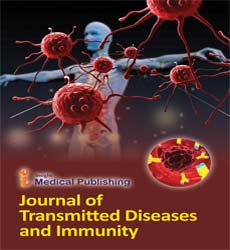
Open Access Journals
- Aquaculture & Veterinary Science
- Chemistry & Chemical Sciences
- Clinical Sciences
- Engineering
- General Science
- Genetics & Molecular Biology
- Health Care & Nursing
- Immunology & Microbiology
- Materials Science
- Mathematics & Physics
- Medical Sciences
- Neurology & Psychiatry
- Oncology & Cancer Science
- Pharmaceutical Sciences
